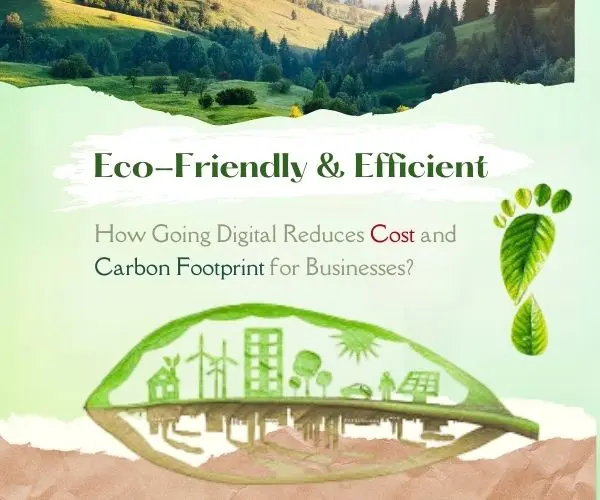In a world where climate change is no longer a distant concern but a present reality, the pressure on businesses to adopt sustainable practices is growing stronger than ever. Consumers, investors, and regulators are all demanding eco-conscious operations—and rightly so. But the good news is that environmental responsibility doesn’t have to come at the cost of efficiency or profit. In fact, embracing digital transformation is proving to be both an environmentally friendly and cost-effective strategy for businesses around the world. As the Indian economy moves toward a digitally empowered future, adopting digital tools and platforms is no longer optional—it’s a strategic necessity. And while the primary motivations may often be business growth, customer convenience, or competition, there's a profound benefit that many overlook: going digital is inherently green. In this article, we explore how digital adoption can help businesses significantly reduce operational costs while also minimizing their carbon footprint, creating a win-win scenario that aligns with the planet’s health and a company’s bottom line. Before understanding how digital solutions can help, it’s important to identify the carbon-intensive nature of traditional business processes: These legacy practices are not only expensive over time, but they also contribute to climate degradation. Going digital isn't just about modernization—it’s about mitigating environmental harm. Replacing physical files with cloud-based storage reduces: Digital solutions like e-signatures, PDF contracts, and centralized systems boost productivity and cut waste. A study shows that producing one ton of paper emits more than 1.5 tons of CO₂. Remote and hybrid models help businesses: Tools like Zoom, Slack, and Teams enable seamless collaboration while reducing environmental impact. Digital marketing minimizes use of materials and enhances targeting. Benefits include: Cloud computing reduces onsite infrastructure needs and leverages green data centers. Benefits include: AI and IoT help monitor and reduce resource usage: Digital events offer: Examples include: All reducing paper, travel, and branch-based operations. Digital transformation is not only eco-friendly, but also financially sound. Efficiency improves, overheads drop, and long-term savings multiply. DigitalizeIndiaNow is a platform helping Indian businesses go digital and eco-friendly. With offerings like: It enables companies to reduce costs and environmental impact while boosting digital presence. Eco-efficiency will define business success in the coming years. With platforms like DigitalizeIndiaNow, Indian enterprises can grow while reducing their footprint—proving that going green and scaling up are not mutually exclusive. Now is the time to embrace digital for a sustainable tomorrow.The Environmental Cost of Traditional Business Operations
Digital Transformation: A Green Game-Changer
1. Paperless Workflows and Documentation
2. Remote Work and Digital Collaboration
3. Digital Marketing Over Print Campaigns
4. Energy-Efficient Cloud Solutions
5. Smart Digital Tools for Resource Optimization
6. Virtual Events and Webinars
7. Digital Financial Operations
Cost Benefits of Going Digital
Case in Point: DigitalizeIndiaNow – A Catalyst for Greener, Smarter Businesses
Steps to Make Your Business More Eco-Digital
Sustainability is the Future of Business
Eco-Friendly & Efficient
16 Apr, 2025 | Posted by Admin
